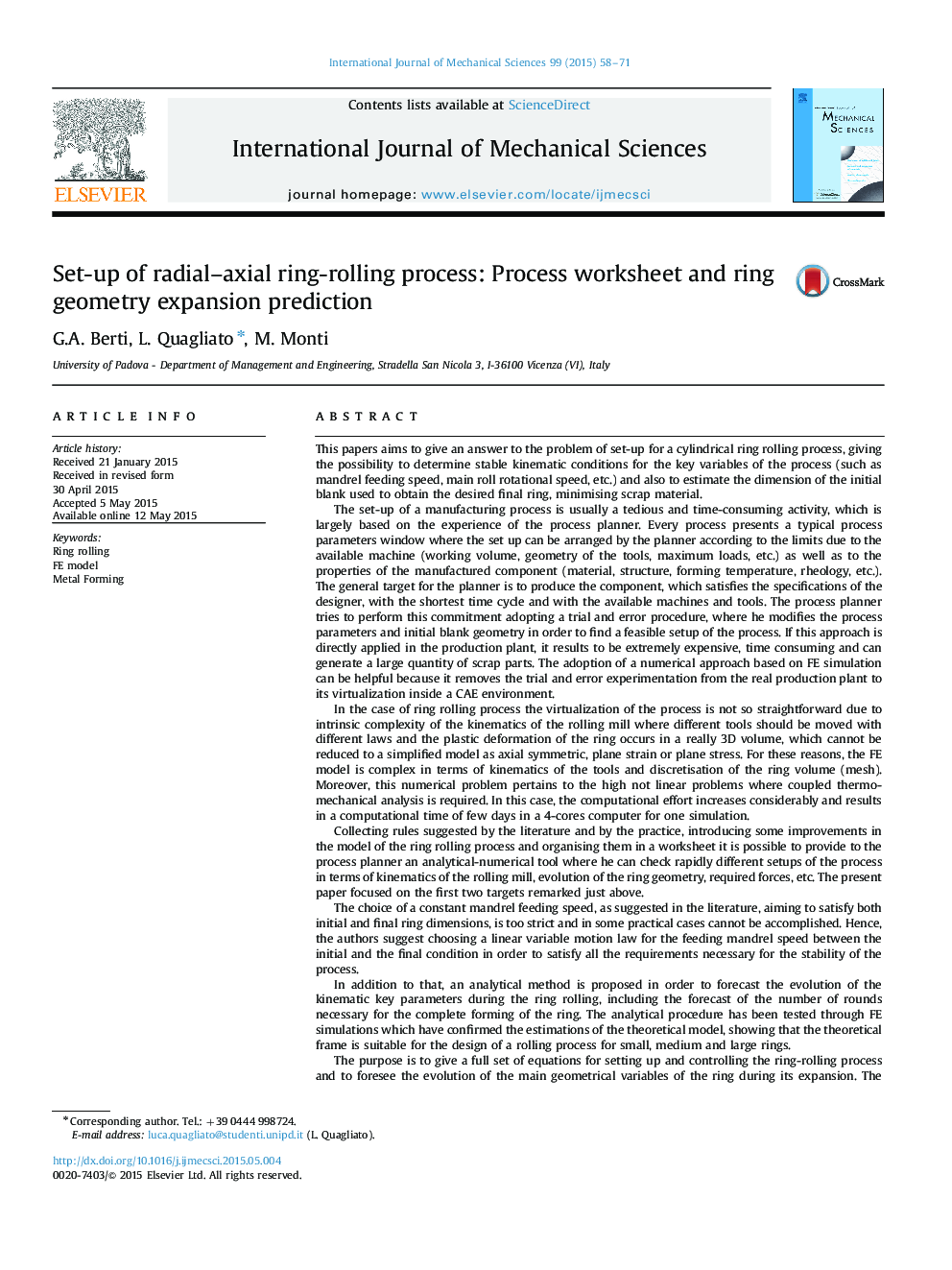| کد مقاله | کد نشریه | سال انتشار | مقاله انگلیسی | نسخه تمام متن |
|---|---|---|---|---|
| 782139 | 1464983 | 2015 | 14 صفحه PDF | دانلود رایگان |
• Improvement of design of feasible kinematic ring rolling process.
• Analytical model predicting ring geometry expansion not in terms of averaged values.
• Procedure implemented in worksheet to determine motion laws of mandrel and axial roll.
• Mandrel linear velocity satisfies biting and feeding at beginning and end of rolling.
• Validation of the analytical model and the procedure by experiment and FE simulation.
This papers aims to give an answer to the problem of set-up for a cylindrical ring rolling process, giving the possibility to determine stable kinematic conditions for the key variables of the process (such as mandrel feeding speed, main roll rotational speed, etc.) and also to estimate the dimension of the initial blank used to obtain the desired final ring, minimising scrap material.The set-up of a manufacturing process is usually a tedious and time-consuming activity, which is largely based on the experience of the process planner. Every process presents a typical process parameters window where the set up can be arranged by the planner according to the limits due to the available machine (working volume, geometry of the tools, maximum loads, etc.) as well as to the properties of the manufactured component (material, structure, forming temperature, rheology, etc.). The general target for the planner is to produce the component, which satisfies the specifications of the designer, with the shortest time cycle and with the available machines and tools. The process planner tries to perform this commitment adopting a trial and error procedure, where he modifies the process parameters and initial blank geometry in order to find a feasible setup of the process. If this approach is directly applied in the production plant, it results to be extremely expensive, time consuming and can generate a large quantity of scrap parts. The adoption of a numerical approach based on FE simulation can be helpful because it removes the trial and error experimentation from the real production plant to its virtualization inside a CAE environment.In the case of ring rolling process the virtualization of the process is not so straightforward due to intrinsic complexity of the kinematics of the rolling mill where different tools should be moved with different laws and the plastic deformation of the ring occurs in a really 3D volume, which cannot be reduced to a simplified model as axial symmetric, plane strain or plane stress. For these reasons, the FE model is complex in terms of kinematics of the tools and discretisation of the ring volume (mesh). Moreover, this numerical problem pertains to the high not linear problems where coupled thermomechanical analysis is required. In this case, the computational effort increases considerably and results in a computational time of few days in a 4-cores computer for one simulation.Collecting rules suggested by the literature and by the practice, introducing some improvements in the model of the ring rolling process and organising them in a worksheet it is possible to provide to the process planner an analytical-numerical tool where he can check rapidly different setups of the process in terms of kinematics of the rolling mill, evolution of the ring geometry, required forces, etc. The present paper focused on the first two targets remarked just above.The choice of a constant mandrel feeding speed, as suggested in the literature, aiming to satisfy both initial and final ring dimensions, is too strict and in some practical cases cannot be accomplished. Hence, the authors suggest choosing a linear variable motion law for the feeding mandrel speed between the initial and the final condition in order to satisfy all the requirements necessary for the stability of the process.In addition to that, an analytical method is proposed in order to forecast the evolution of the kinematic key parameters during the ring rolling, including the forecast of the number of rounds necessary for the complete forming of the ring. The analytical procedure has been tested through FE simulations which have confirmed the estimations of the theoretical model, showing that the theoretical frame is suitable for the design of a rolling process for small, medium and large rings.The purpose is to give a full set of equations for setting up and controlling the ring-rolling process and to foresee the evolution of the main geometrical variables of the ring during its expansion. The proposed worksheet offers process planners and engineers a useful starting-point from which to reduce the required amount of FE simulation needed to forecast the process and to simulate it using a previously screened range for all key process parameters.
Journal: International Journal of Mechanical Sciences - Volume 99, August 2015, Pages 58–71
